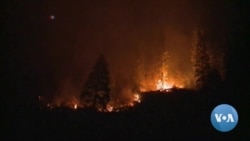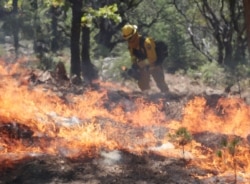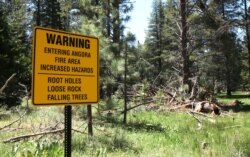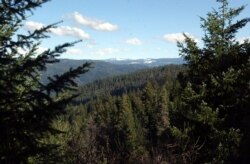As wildfires in the Western United States continue to worsen under the influence of climate change, one project offers hope on how to begin to confront a problem of enormous proportions.
More than 1.5 million hectares have burned in California alone this year, shattering the state's previous record. Across the West, the number of large fires per year has tripled, and the acreage burned has grown six-fold since the 1970s. The trends are expected to continue with climate change.
The worst of these fires are preventable. The solutions are known. But the area involved is far too vast for the agencies in charge of managing it.
In California's Placer County, an unusual partnership between a county water utility, the U.S. Forest Service and environmentalists is taking on the work to prevent catastrophic fires on more than 11,000 hectares in the northern Sierra Nevada Mountains.
It is happening because devastated forests are not just a loss for nature lovers. Mountain forests in particular are critical sources of clean water. In California, the Sierra Nevada Mountains and the forests that blanket them are the source of nearly two-thirds of the water in the state's reservoirs and aqueducts.
With millions of hectares of land around the West in need of restoration, experts see the French Meadows project as a model for how to start tackling wildfire prevention needs that are growing increasingly urgent.
Rising from the ashes
The partnership arose from the ashes of 2014's King fire.
That fire roared through the Eldorado National Forest with "just unheard of, mind-blowing speed," said Forest Service District Ranger Michael Woodbridge. Winds blew the fire through more than 20 kilometers of the Rubicon River valley in half a day.
"It sounded like a hundred freight trains coming through that watershed," said Andy Fecko, general manager of the Placer County Water Agency (PCWA).
The county water utility manages two reservoirs in the region, providing drinking water to 250,000 people, irrigating 2,800 hectares of agricultural land and generating more than 1 million megawatt hours of electricity per year.
The forest around PCWA's Hell Hole Reservoir was part of the 400-square kilometers the King fire left blackened. It looked like "nuclear Armageddon," Fecko said.
But the problems did not end when the fire went out.
When heavy rains fell, the denuded hills had no vegetation to shield the ground and nothing to hold it together.
"The soils began to melt off of those hillsides," Fecko said.
Mud poured downstream into the reservoir, filling it with sediment. Dead trees blocked the outflow gates. Rising waters threatened to overtop the dam, which could lead to erosion that could destroy the structure. PCWA had to shut down the hydroelectric plant. The reservoir had to be dredged and the debris cleared.
"Every time we do that, it's a 5- to 7-million-dollar cost that you incur. And you're out of business during the whole time when you're trying to clear those facilities out," Fecko said. "And we incurred those costs several years in a row."
"That really was a wake-up call," he added.
Nearly every watershed in the Western United States will have to deal with increased erosion following wildfires by the 2040s as climate change ratchets up, according to a recent study. More than a third of them are expected to have to deal with sedimentation rates that are double what they are seeing now. That affects both the quantity and quality of water for those downstream who depend on it.
Rather than waiting for the next megafire, PCWA decided it would be cheaper to try to prevent it. The agency started looking for ways to protect the forest around the French Meadows Reservoir.
Victim of success
The scale of the West's wildfire problem is staggering. The U.S. Forest Service manages about one-fifth of the total land area in California. Of those 8 million hectares, the agency estimates that between 2.4 million and 3.6 million need restoration to prevent catastrophic fires.
And that's just California.
Restoring one hectare of forest land can easily cost $2,500 or more. The tab quickly runs into the billions of dollars. In recent years, as catastrophic wildfires have become more common, firefighting has consumed much of the Forest Service's budget for restoration.
Ironically, the wildfire threat arose from a century of success fighting fires.
Fire is a natural part of the ecosystem in Western forests. Before European settlers arrived in the 1800s, low-intensity wildfires routinely burned through forest undergrowth.
Settlers saw fire as a threat, however. For the last century or so, fire suppression has been the name of the game.
But now the West is dealing with the unforeseen consequences.
Without fires to clear them out, the forests have filled in. Brush and smaller trees have grown up between the largest, hardiest trees.
The extra vegetation creates conditions that make wildfires more severe and more likely. Denser forests need more water, making them more vulnerable to drought.
When a fire starts, the brush and small trees become "ladder fuels," allowing flames to climb from the forest floor to the treetops and incinerate everything in between.
Climate change turbocharges the process. Warming temperatures raise water demands further. The forests dry out faster. And climate change is amplifying droughts to historic proportions.
While more fires are inevitable, experts say thinning out the forests would keep them from becoming catastrophic megafires.
The problem is the scale. Woodbridge says there are more than 100,000 hectares of forest in his district alone, one of four in the Tahoe National Forest.
"We're not going to be able to treat all of that, at least not all at once," he said. "So, we have to prioritize."
Priority goes to populated areas, the interstate highway, railroads and pipelines, he said.
Under threat
PCWA's French Meadows Reservoir sits 1,600 meters up in the Sierra Nevada Mountains, deep inside the Tahoe National Forest.
"It is a forested landscape that hasn't burned at any intensity in a long time," Fecko said. "It was one of these watersheds that was very much under threat of a high-intensity wildfire."
But it was not at the top of the Forest Service's list, Woodbridge said.
"We're always doing as much as we can with the capacity we have," he said, "but French Meadows is above and beyond what that capacity would have been."
At the same time, environmental nonprofit The Nature Conservancy had been working to restore 4,000 hectares nearby.
They all realized they had a common interest in preventing a catastrophic wildfire.
Working together, they pulled in more funding sources and expertise than any individual group could muster. That "allows us to get the work done faster and on a larger scale than if it were just the Forest Service going alone," said Angel Hertslet, who leads The Nature Conservancy's part of the project.
The state government provided the bulk of the funding, but The Nature Conservancy brought in several beverage companies with bottling plants downstream. While their contributions were relatively small, "it gave us another opportunity to go back to the (state, federal and local governments) to say, 'Hey, we have private people who don't even live around here that want this and want to invest in it,'" said Brett Storey, project manager for Placer County. That helped with the budget request, he said.
The preliminary environmental assessment took 18 months.
"To me, that's just twice as long as it should be, and it cost twice as much as it should," Storey said. "When we presented that to the Forest Service, they laughed. They said that's half as much as what it would cost us, and half as long as it would have taken" without the partners' contributions.
The project is well into its second year. Workers cleared out more than 400 hectares last year, focusing on forests near campgrounds and roads, where human activity is most likely to spark a fire.
Over the course of the next eight to 10 years, the project aims to lower the fire risk on 11,000 hectares.
"That whole project is work that wouldn't have gotten done if we were not getting the assistance of partners to make it happen," Woodbridge said.
There is much, much more to do, however.
"It's a drop in the bucket," Hertslet said, "but it's important because it can provide us with a new model for how we do this work."
The Nature Conservancy already is planning a similar project 10 times bigger to the north of French Meadows.
Denver, Colorado Springs and a few other Western water utilities are investing in their forested watersheds. But it is not common.
As climate change continues to ratchet up, the rest of the West should look at what is happening in French Meadows, Fecko said.
"All these counties are going to have to start thinking about ways that they can mitigate the impacts of wildfire," he said. "Otherwise, they're going to have the same fate that California does."















